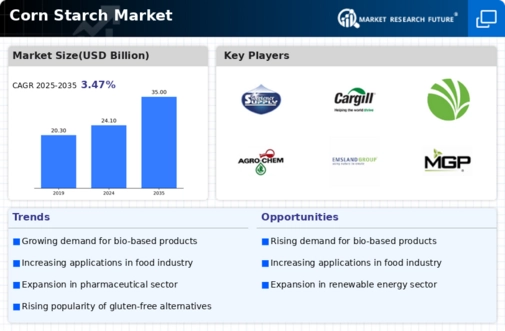Corn Starch Size
Corn Starch Market Growth Projections and Opportunities
The Corn Starch Market is influenced by a myriad of factors that collectively shape its dynamics, ranging from agricultural practices to global economic trends. One fundamental factor is the supply of corn, which is the primary raw material for corn starch production. Weather conditions, planting patterns, and crop yields directly impact the availability of corn, influencing the overall supply chain. Fluctuations in corn production can result from natural factors such as droughts or excessive rainfall, affecting the quantity and quality of corn starch in the market.
Market demand is another crucial factor driving the Corn Starch Market. The diverse applications of corn starch, spanning the food and beverage industry, pharmaceuticals, and industrial sectors, contribute to its widespread demand. Changes in consumer preferences, dietary trends, and technological advancements in end-use industries play a pivotal role in shaping the overall demand for corn starch. For instance, the growing preference for natural and clean-label ingredients in the food industry has increased the demand for corn starch as a versatile and recognizable ingredient.
Global economic conditions and trade policies significantly impact the Corn Starch Market. As a globally traded commodity, corn starch is subject to international market dynamics, including currency fluctuations, trade tariffs, and geopolitical events. Changes in trade agreements or disruptions in the global supply chain can influence the pricing and availability of corn starch on a global scale, affecting both producers and consumers.
Technological advancements and innovation in corn starch processing contribute to the market's growth and competitiveness. Continuous research and development efforts in refining extraction methods, modifying starch properties, and developing new applications enhance the functionality and versatility of corn starch. Technological innovation also plays a role in optimizing production processes, improving efficiency, and reducing environmental impact, positioning companies within the market based on their ability to adopt and implement new technologies.
Regulatory factors are integral to the Corn Starch Market, as government regulations and standards impact various aspects of production, distribution, and marketing. Regulations related to food safety, labeling, and environmental sustainability can influence how companies operate within the market. Compliance with these regulations not only ensures product quality and safety but also determines a company's market access and reputation.
Consumer awareness and preferences regarding health and sustainability are increasingly shaping the Corn Starch Market. The demand for natural, non-GMO, and organic products has grown, prompting manufacturers to adapt their offerings to meet these preferences. Moreover, increased awareness of environmental issues has led to a surge in demand for sustainable and eco-friendly packaging solutions, influencing the choices made by both producers and consumers in the corn starch market.
Competitive factors, including market concentration, brand recognition, and pricing strategies, play a significant role in determining the success of companies in the Corn Starch Market. Larger, well-established players may benefit from economies of scale, while smaller, niche players may focus on specialty or high-value segments. Pricing strategies, influenced by production costs and market demand, also contribute to a company's competitive positioning within the market.no











Leave a Comment